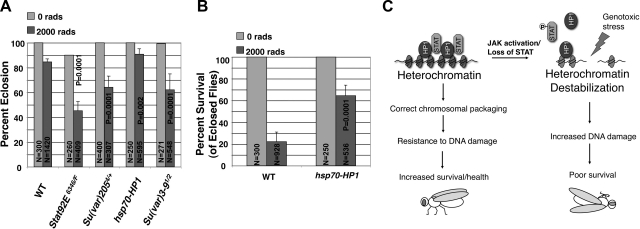Figure 7.
Unphosphorylated STAT and heterochromatin confer resistance to radiation-induced lethality. A) Third-instar larvae of indicated genotypes were irradiated with 2000 rad of γ-rays, and eclosion rates were calculated. At least 3 independent experiments were done for each genotype. P values were calculated using Student's t test by comparing the effect of each mutant/transgene to wild-type controls. N represents total number of larvae counted. Error bars = sd. B) Calculated survival rates for irradiated flies of the indicated genotypes 2 d after eclosion. At least 7 independent experiments were done for each genotype. P values were calculated using Student's t test by comparing the effect of hsp70-HP1 expression to wild-type controls. Error bars = sd. C) Model for protecting genome stability by STAT and heterochromatin: Unphorsphorylated STAT interacts with HP1 to stabilize heterochromatin and protects genomic DNA from damage and imparts resistance to radiation-induced lethality. Activation of JAK leads to decreased levels of unphosphorylated STAT, which in turn causes loss of heterochromatin stability, thus increasing DNA damage and lethality under conditions of genotoxic stress.

